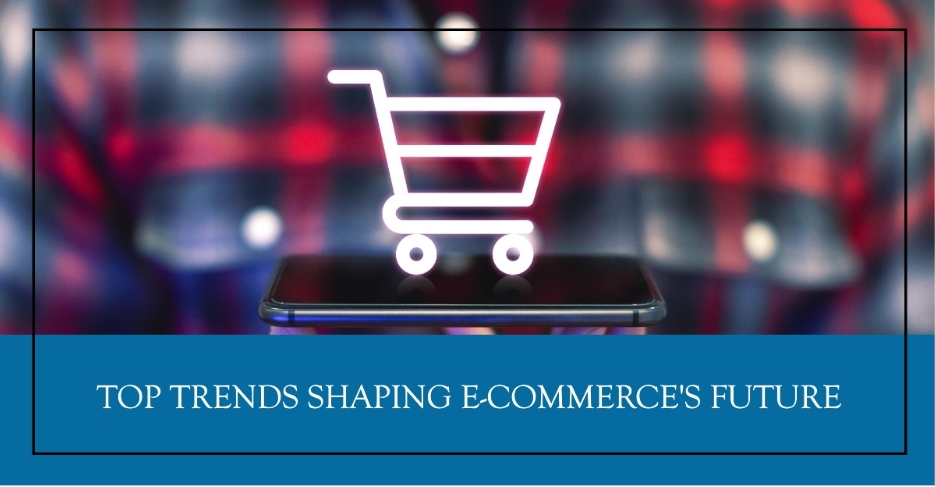Top Trends Shaping the Future of E-commerce
Introduction:
The e-commerce industry is undergoing rapid transformation, driven by technological advancements and changing consumer behaviors. These changes are not only reshaping how businesses operate but also how consumers interact with brands. Understanding the top trends shaping the future of e-commerce is essential for businesses looking to stay competitive in this dynamic landscape.
As we move forward, several key trends are emerging that promise to redefine the e-commerce experience. From the rise of mobile commerce to the growing importance of sustainability, these trends are set to influence every aspect of online retail. This article explores the most significant trends that will shape the future of e-commerce, providing insights into how businesses can adapt and thrive in this ever-evolving environment.
The Rise of Mobile Commerce:
“Mobile commerce, or m-commerce, is becoming increasingly dominant in the e-commerce sector. With the widespread adoption of smartphones and tablets, consumers are now more likely to shop using their mobile devices. This shift is driving businesses to optimize their websites and platforms for mobile use, ensuring a seamless shopping experience across all devices.” Says Holly Darani, SEO Specialist at TheWealthPoint
The convenience of mobile shopping, coupled with advancements in mobile payment technologies, is fueling this trend. Features like one-click purchasing, mobile wallets, and secure payment gateways are making it easier for consumers to buy products on the go. Businesses that prioritize mobile optimization are likely to see increased engagement and higher conversion rates as a result.
The Growth of Social Commerce:
“Social media platforms are evolving into powerful e-commerce channels, a trend known as social commerce. Platforms like Instagram, Facebook, and TikTok are integrating shopping features, allowing users to purchase products directly from social media posts. This integration is blurring the lines between social interaction and shopping, creating new opportunities for businesses to reach their target audiences.” Says Sai Blackbyrn, CEO of Coach Foundation
Influencer marketing is playing a significant role in the growth of social commerce. Influencers can leverage their large followings to promote products, driving traffic and sales for brands. Businesses are increasingly collaborating with influencers to create authentic and engaging content that resonates with consumers, further enhancing the social commerce experience.
The Importance of Personalization:
Personalization is becoming a critical component of the e-commerce experience. Consumers expect tailored recommendations and personalized interactions when shopping online. Leveraging data and artificial intelligence, businesses can analyze customer behavior and preferences to deliver customized product suggestions, targeted marketing messages, and personalized shopping experiences.
By offering a personalized experience, businesses can increase customer satisfaction and loyalty. Personalized recommendations can lead to higher conversion rates and larger average order values. In addition, personalization helps build stronger relationships with customers, as they feel understood and valued by the brand.
The Shift to Sustainable Practices:
“Sustainability is a growing concern for consumers, and it is influencing their purchasing decisions. As awareness of environmental issues increases, consumers are seeking out brands that demonstrate a commitment to sustainable practices. This trend is pushing e-commerce businesses to adopt more eco-friendly operations and offer sustainable products.” Says Sai Blackbyrn, CEO of Coach Foundation
From reducing packaging waste to sourcing materials responsibly, businesses are making changes to minimize their environmental impact. Sustainability is not only beneficial for the planet but also for building a positive brand image. Companies that prioritize sustainability are likely to attract environmentally conscious consumers and foster long-term loyalty.
The Expansion of Omnichannel Retail:
Omnichannel retailing is becoming essential as consumers expect a seamless shopping experience across multiple channels. This approach integrates various shopping methods, such as online, in-store, and mobile, providing a cohesive experience regardless of how customers choose to shop. Businesses are investing in technologies that enable them to deliver a consistent and connected experience across all touchpoints.
The expansion of omnichannel retail is driven by the need to meet consumers wherever they are. By offering options like buy online, pick up in-store (BOPIS) and seamless cross-channel returns, businesses can enhance convenience and flexibility for their customers. An effective omnichannel strategy can lead to increased customer satisfaction and higher sales.
The Integration of Augmented Reality:
Augmented Reality (AR) is revolutionizing the e-commerce experience by allowing consumers to visualize products in their real-world environment before making a purchase. AR technology enables shoppers to see how products, such as furniture or clothing, will look in their space or on their person, enhancing the decision-making process.
The use of AR in e-commerce is particularly beneficial for reducing return rates. When customers can visualize products accurately, they are more likely to be satisfied with their purchase, leading to fewer returns. Additionally, AR provides an interactive and engaging shopping experience, which can attract and retain customers.
The Role of Artificial Intelligence:
Artificial Intelligence (AI) is playing an increasingly significant role in e-commerce. AI technologies, such as chatbots, predictive analytics, and machine learning, are enhancing various aspects of the online shopping experience. Chatbots, for example, provide instant customer support, answering queries and assisting with purchases around the clock.
Predictive analytics powered by AI can help businesses anticipate customer needs and preferences, allowing for more effective inventory management and marketing strategies. Machine learning algorithms can analyze vast amounts of data to identify trends and patterns, enabling businesses to make data-driven decisions and optimize their operations.
The Impact of Fast and Free Shipping:
“Fast and free shipping has become a standard expectation among online shoppers. The convenience of quick delivery times and the appeal of free shipping options can significantly influence purchasing decisions. E-commerce businesses are investing in logistics and supply chain solutions to meet these demands and stay competitive.
Offering fast and free shipping can lead to increased customer satisfaction and loyalty. However, it also presents challenges for businesses, such as managing costs and maintaining profitability. Companies are exploring innovative solutions, such as partnering with third-party logistics providers and implementing efficient fulfillment processes, to balance speed and cost-effectiveness.” Says Daniel Foley, head of content at Believe Money
The Influence of Voice Commerce:
Voice commerce is an emerging trend driven by the increasing use of voice-activated devices like smart speakers. Consumers are using voice commands to search for products, make purchases, and manage their shopping lists. This trend is reshaping the e-commerce landscape, requiring businesses to optimize their content and interfaces for voice search.
The convenience of voice commerce appeals to consumers looking for hands-free and efficient shopping experiences. Businesses that adapt to this trend by integrating voice commerce capabilities can tap into a growing market segment and provide a more accessible shopping experience for their customers.
The Future of Payment Methods:
“The evolution of payment methods is shaping the future of e-commerce. Digital wallets, cryptocurrencies, and buy now, pay later (BNPL) options are becoming increasingly popular among consumers. These payment methods offer convenience, security, and flexibility, enhancing the overall shopping experience.” Says Jon Lynn, founder of My Office Pod
Adopting diverse payment options can help businesses cater to a broader audience and reduce cart abandonment rates. Consumers appreciate having multiple payment choices that suit their preferences and financial situations. By staying ahead of payment trends, e-commerce businesses can improve customer satisfaction and drive sales.
Conclusion:
The future of e-commerce is being shaped by a variety of trends that are transforming how businesses operate and how consumers shop. From the rise of mobile and social commerce to the growing importance of personalization and sustainability, these trends offer both opportunities and challenges for businesses. Embracing these changes and staying adaptable will be crucial for success in the evolving e-commerce landscape.
By understanding and leveraging the top trends in e-commerce, businesses can enhance their strategies, improve customer experiences, and drive growth. As technology continues to advance and consumer preferences evolve, staying informed and proactive will be key to thriving in the competitive world of online retail.







